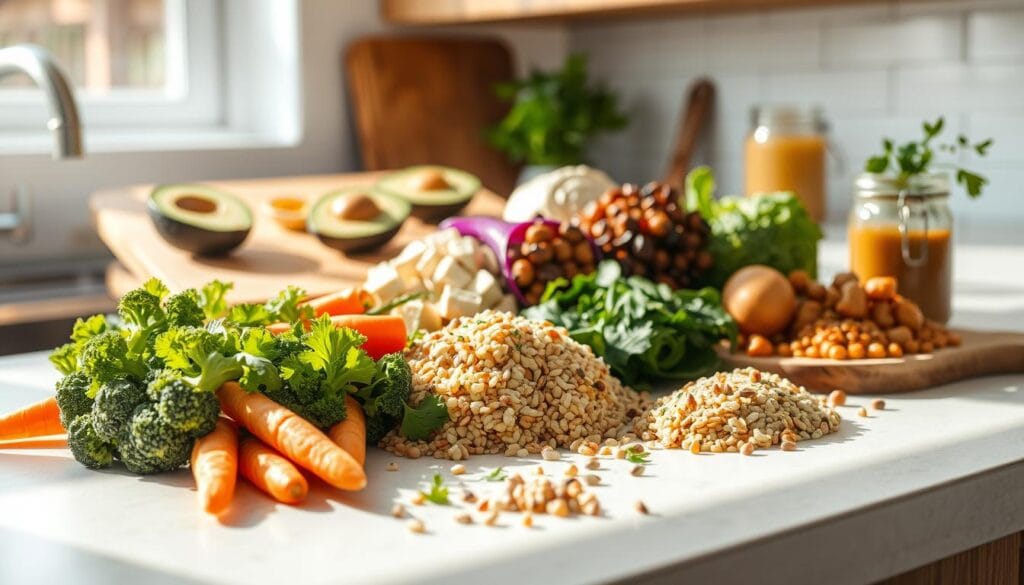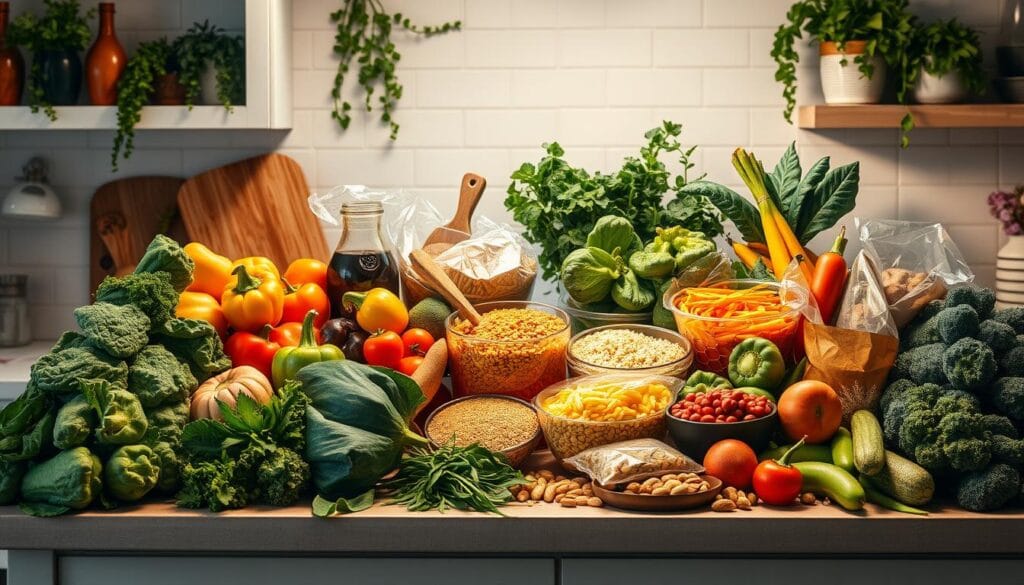Ever felt overwhelmed by daily meal decisions? Vegan meal prep could be your ultimate solution. Imagine walking into your kitchen and finding perfectly portioned, nutritious plant-based meals ready to go. No stress, no last-minute cooking, just delicious food that supports your health goals.
Vegan meal prep is more than just cooking in advance. It’s a strategic approach to plant-based meal planning. This approach transforms how you eat, save time, and nourish your body. By dedicating a few hours each week to preparing meals, you can revolutionize your eating habits and reclaim precious time.
Approximately 3% of the U.S. population now identifies as vegan, and the trend is growing. Studies show that meal prepping can save up to 5 hours per week. It also helps 70% of people maintain healthier eating habits. Your journey into vegan meal prep starts right here.
Table of Contents
Understanding Vegan Meal Prep Fundamentals
Vegan meal prepping changes how you think about food. It makes planning meals easy and healthy. This way, you can eat well and stay healthy.
Getting into veggie meal prep is more than just picking food. It’s about living a healthy, green lifestyle. It feeds your body and helps the planet.
Benefits of Plant-Based Meal Planning
Plant-based meals are great for your health and life:
- They lower the risk of heart disease and diabetes
- They help with weight control
- They’re better for the environment
- They encourage green eating
Essential Components of Vegan Meal Prep
A good vegan meal has:
- Protein sources: Lentils, tofu, chickpeas
- Whole grains: Quinoa, brown rice, bulgur
- Vegetables: Full of color and nutrients
- Healthy fats: Avocado, nuts, seeds
Time and Cost Benefits
Meat-free meal prep saves money and time. Cooking big batches of grains and beans makes things easier. It also cuts down on food waste.
Efficient meal preparation is the key to maintaining a consistent and nutritious vegan diet.
Smart veggie meal prep lets you try new, tasty dishes. It meets your nutritional needs and saves time when you’re busy.
Getting Started with Vegan Meal Prep
Starting a meatless meal prep journey can feel daunting. But, with a simple approach, you’ll soon master cruelty-free meal prep. Begin with basic steps and grow your confidence in cooking plant-based dishes.
First, pick a meal prep method that fits your life. You have three main options:
- Batch Cooking: Cook big batches of key ingredients
- Make-Ahead Meals: Prepare full meals ahead of time
- Portioned Meals: Split food into single servings
Planning your vegan meal prep budget can be easy. You can make tasty plant-based meals for about $9 a day. This adds up to around $63.21 for a week’s worth of food.
| Meal Prep Strategy | Benefits | Time Investment |
|---|---|---|
| Batch Cooking | Versatile ingredients | 2-3 hours on weekend |
| Make-Ahead Meals | Complete meals ready | 3-4 hours of preparation |
| Portioned Meals | Easy grab-and-go options | 1-2 hours of organizing |
Pro tip: Start with easy recipes and grow your collection. Use versatile ingredients like lentils, chickpeas, and rice. They can turn into many dishes. Aim to prep 21 meals a week for the best efficiency.
Successful vegan meal prep is about making a routine that works for you. Feel free to try new things and find what suits you best!
Essential Equipment and Storage Solutions
Starting a dairy-free meal plan needs the right tools. You’ll need containers, tools, and storage to keep your meals fresh and organized.
Must-Have Containers and Tools
Quality storage containers are key for meal prep. Here are some top picks:
- Glass containers with locking lids (29 oz capacity)
- Stasher Reusable Silicone Bags for versatile storage
- Snapware Total Solution 20-Piece Food Storage Set
- Souper Cubes for freezing individual portions
Storage Tips for Maximum Freshness
Keeping your meals fresh is all about smart storage. Choose containers that are microwave, dishwasher, and freezer safe for easy use and long-lasting freshness.
| Container Type | Pros | Cons | Price Range |
|---|---|---|---|
| Glass Containers | Durable, No flavor retention | Heavier, More expensive | $6-$10 each |
| Plastic Containers | Lightweight, Affordable | Can stain, Flavor absorption | $22-$30 per set |
| Silicone Bags | Collapsible, Versatile | Limited durability | $10-$25 |
Organization Strategies
Plan your dairy-free meals with these tips:
- Prepare 8-10 containers per week
- Use stackable containers to save space
- Label containers with meal and date
- Arrange containers by meal type and preparation date
Good meal prep is about finding a system that fits your life and diet.
Building Balanced Vegan Meals

Making balanced vegan meals is like an art. It mixes nutrition, taste, and organizing plant-based meals. Your strategy for vegan meal batch cooking should aim to make plates that are both nutritious and tasty.
The Vegan Plate Method is a simple way to plan meals. It helps you make complete plant-based meals:
- Protein (¼ of the plate): Use protein-rich foods like tofu, tempeh, or legumes
- Complex Carbohydrates (¼ of the plate): Choose whole grains and starchy veggies
- Vegetables (½ of the plate): Add a variety of colorful veggies
- Healthy Fats: Add nuts, seeds, or avocado in small amounts
When planning your vegan meal batch cooking, think about protein. Air-fried tofu can have up to 27 grams of protein per serving. Chickpea curry has about 11-16 grams.
Here are some tips for organizing plant-based meals:
- Change up your protein sources for better nutrition
- Prep ingredients ahead of time
- Use fortified plant-based products for extra nutrients
- Try different global cuisines for more flavors
By following these tips, you’ll make vegan meals that are both healthy and delicious. They will support your health and make cooking fun.
Plant-Based Protein Sources for Meal Prep
Creating a great vegan meal prep means knowing about different protein sources. These keep your meals balanced and tasty. Protein is key for muscles, energy, and health, especially in vegan diets.
Your vegan meal prep can include many protein-rich foods. These foods are not just high in protein. They also have important vitamins and minerals.
Complete Protein Options
Complete proteins have all nine amino acids your body needs. Some top vegan complete proteins are:
- Quinoa (8 grams of protein per 1 cup)
- Tofu (8 grams per 3-ounce serving)
- Tempeh (11 grams per 3-ounce serving)
- Ezekiel bread (8 grams per two slices)
Legumes and Pulses
Legumes are full of protein and fiber in vegan meal prep. They are very nutritious:
- Beans: 15 grams of protein per cup
- Lentils: 18 grams of protein per cup
- Edamame: 17 grams of protein per cup
Meat Alternatives
Today’s meat alternatives are easy to use for vegan meal planning. Look at these options:
- Quorn Chik’N patties (9 grams of protein per 75-gram serving)
- Seitan (34 grams of protein per 1/2 cup)
- Plant-based burger substitutes
By mixing these protein sources, you can make vegan meals that are both healthy and filling. They help you reach your health and fitness goals.
Smart Shopping for Vegan Meal Prep

Starting with smart grocery shopping is key to mastering vegan meal prep. Making the right choices helps balance nutrition, flavor, and budget. Learning to shop well can make your plant-based cooking better.
Planning your shopping strategy involves several key approaches:
- Buy seasonal produce to reduce costs
- Purchase ingredients in bulk
- Explore frozen vegetable options
- Read labels carefully for vegan-friendly products
Building a good vegan pantry means focusing on versatile staples. Black beans, quinoa, and nuts are great for protein and keep costs down.
| Ingredient Category | Budget-Friendly Options | Average Cost per Serving |
|---|---|---|
| Proteins | Black beans, tofu, edamame | $0.50-$1.50 |
| Grains | Quinoa, rice, oats | $0.25-$0.75 |
| Vegetables | Frozen mixed vegetables, seasonal produce | $0.30-$1.00 |
Pro tip: Use bulk sections for spices, dry goods, and nuts to save money during vegan meal prep.
With smart shopping, you can keep your weekly grocery budget under $50. Freeze leftovers, plan meals ahead, and enjoy tasty meat-free dishes while saving money.
Time-Saving Batch Cooking Techniques
Meatless meal prep can change your kitchen routine for the better. It makes cooking quick and easy. Batch cooking is a key strategy for making many meals fast, all while being kind to animals.
Efficient batch cooking needs good planning and smart methods. Spend a few hours each week cooking. This way, you can make tasty plant-based meals that save you time and reduce stress.
Efficient Cooking Methods
Boost your kitchen’s productivity with these batch cooking tips:
- Use an Instant Pot to cut cooking time in half
- Prioritize proteins that take longer to prepare
- Cook starches like rice and quinoa simultaneously
- Utilize rice cookers to free up stove space
Multi-Tasking in the Kitchen
Make your meatless meal prep more efficient with these multi-tasking tips:
- Chop all vegetables at the beginning of your prep session
- Set up mise en place with pre-measured ingredients
- Use multiple cooking appliances at once
- Minimize clean-up by cooking similar dishes in the same pan
Make-Ahead Components
Create versatile components for your cruelty-free meal prep. These can be mixed and matched all week:
- Prepare large batches of sauces and dressings
- Roast vegetables in bulk
- Cook grains and legumes in advance
- Freeze individual portions for easy reheating
By using these batch cooking methods, you’ll save time, feel less stressed, and enjoy tasty vegan meals all week.
Weekly Meal Planning Strategies
Starting with dairy-free meal planning means setting up a flexible system. This keeps your meals both exciting and healthy. Many people find success by dedicating a day, often Sunday, to meal prep. This approach helps streamline your week and lowers stress about food choices.
Ethical meal prepping begins with smart planning. Try themed nights like Meatless Monday or Taco Tuesday to boost meal variety by up to 30%. By changing grains, spices, or sauces, you can avoid meal boredom. This method keeps meals fresh and supports a diverse diet, which can enhance health by 20%.
Use technology to make meal planning easier. Meal planning apps can cut down prep time by about 25%. They also help track nutrients, increasing your chance of meeting dietary goals by 40%. Plus, cooking extra for leftovers can save 50% on prep time, saving you energy and time all week.
Successful meal planning is all about balance. Be open to change and involve your family. Keep a well-stocked pantry with vegan basics and use seasonal produce. This way, you’ll have a sustainable meal prep routine that supports your health and lifestyle.

